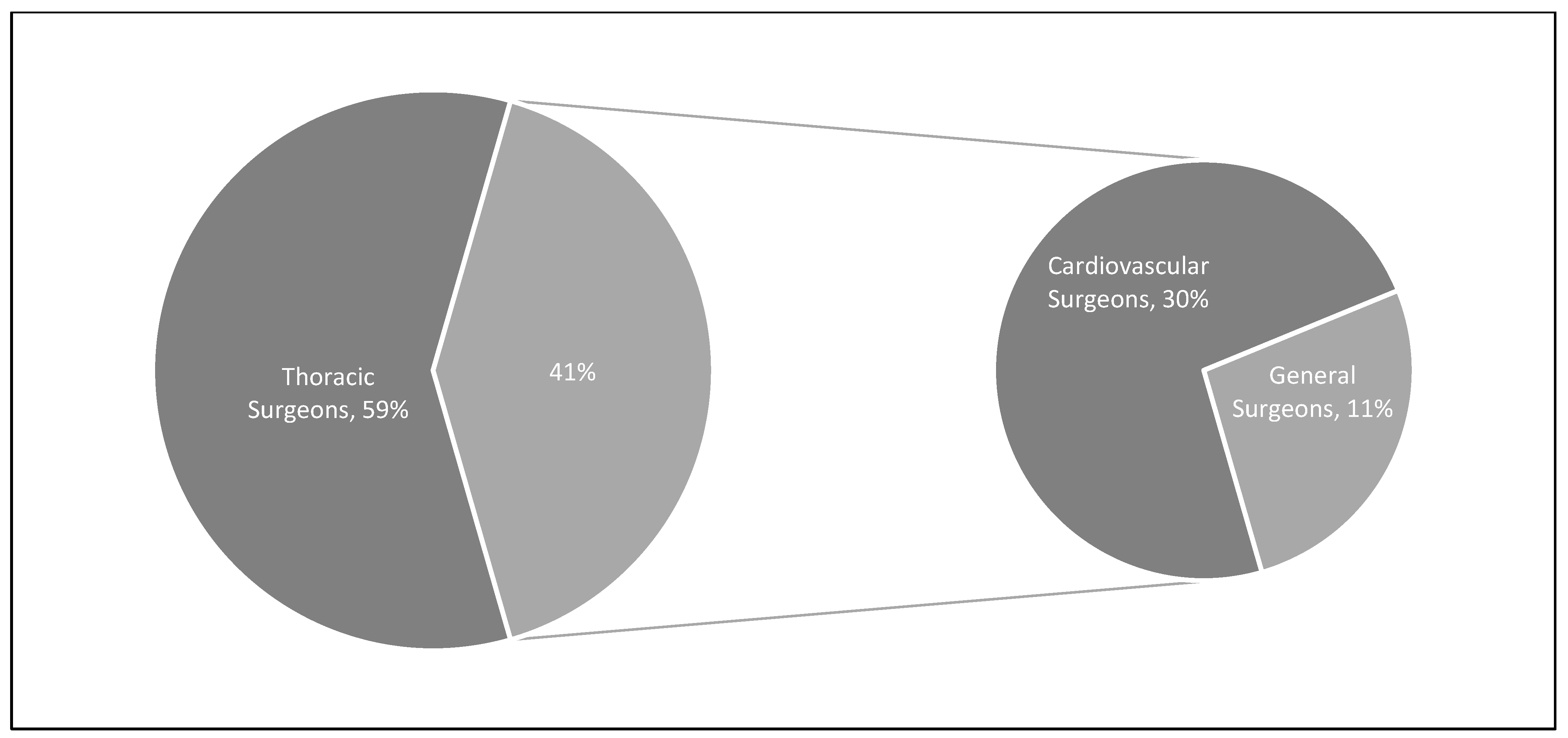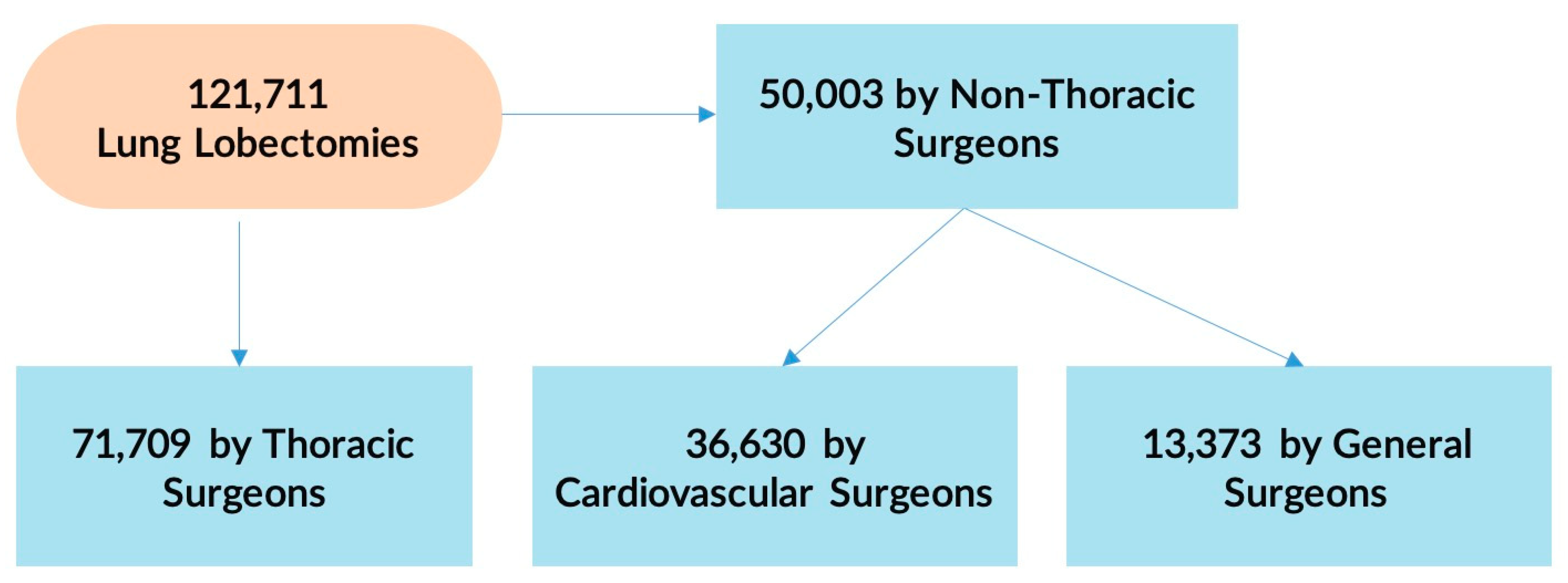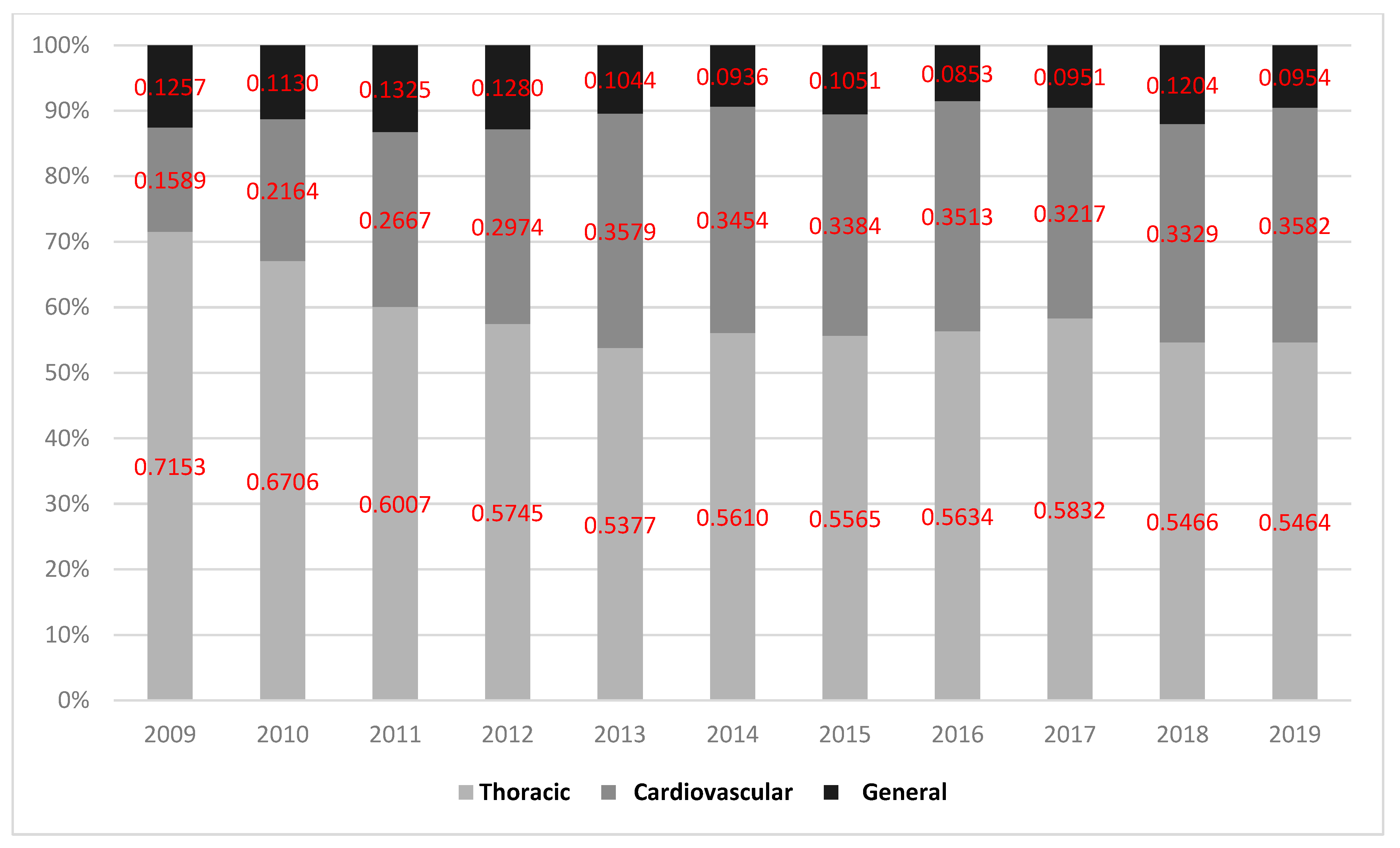Disparities in Access to Thoracic Surgeons among Patients Receiving Lung Lobectomy in the United States
Abstract
1. Introduction
2. Materials and Methods
2.1. Data Source
2.2. Patient Selection
2.3. Outcome Measures
2.4. Statistical Analysis
3. Results
4. Discussion
5. Conclusions
Author Contributions
Funding
Institutional Review Board Statement
Informed Consent Statement
Data Availability Statement
Conflicts of Interest
References
- Chowdhury, M.M.; Dagash, H.; Pierro, A. A Systematic Review of the Impact of Volume of Surgery and Specialization on Patient Outcome. Br. J. Surg. 2007, 94, 145–161. [Google Scholar] [CrossRef] [PubMed]
- Cataneo, J.L.; Veilleux, E.; Lutfi, R. Impact of Fellowship Training on Surgical Outcomes after Appendectomies: A Retrospective Cohort Study. Surg. Endosc. 2021, 35, 4581–4584. [Google Scholar] [CrossRef] [PubMed]
- Rhee, D.; Papandria, D.; Yang, J.; Zhang, Y.; Ortega, G.; Colombani, P.M.; Chang, D.C.; Abdullah, F. Comparison of Pediatric Surgical Outcomes by the Surgeon’s Degree of Specialization in Children. J. Pediatr. Surg. 2013, 48, 1657–1663. [Google Scholar] [CrossRef]
- Farjah, F.; Flum, D.R.; Varghese, T.K.; Symons, R.G.; Wood, D.E. Surgeon Specialty and Long-Term Survival after Pulmonary Resection for Lung Cancer. Ann. Thorac. Surg. 2009, 87, 995–1004, discussion 1005–1006. [Google Scholar] [CrossRef]
- Schipper, P.H.; Diggs, B.S.; Ungerleider, R.M.; Welke, K.F. The Influence of Surgeon Specialty on Outcomes in General Thoracic Surgery: A National Sample 1996 to 2005. Ann. Thorac. Surg. 2009, 88, 1566–1573. [Google Scholar] [CrossRef] [PubMed]
- Hernandez-Vaquero, D.; Vigil-Escalera, C.; Pérez-Méndez, I.; Gutiérrez, A.; Avanzas, P.; Wei, Y.; Diaz, R.; Silva, J.; Moris, C.; Pascual, I. Survival after Thoracoscopic Surgery or Open Lobectomy: Systematic Review and Meta-Analysis. Ann. Thorac. Surg. 2021, 111, 302–313. [Google Scholar] [CrossRef] [PubMed]
- Paul, S.; Altorki, N.K.; Sheng, S.; Lee, P.C.; Harpole, D.H.; Onaitis, M.W.; Stiles, B.M.; Port, J.L.; D’Amico, T.A. Thoracoscopic Lobectomy Is Associated with Lower Morbidity than Open Lobectomy: A Propensity-Matched Analysis from the STS Database. J. Thorac. Cardiovasc. Surg. 2010, 139, 366–378. [Google Scholar] [CrossRef]
- Blasberg, J.D.; Seder, C.W.; Leverson, G.; Shan, Y.; Maloney, J.D.; Macke, R.A. Video-Assisted Thoracoscopic Lobectomy for Lung Cancer: Current Practice Patterns and Predictors of Adoption. Ann. Thorac. Surg. 2016, 102, 1854–1862. [Google Scholar] [CrossRef]
- Birkmeyer, J.D.; Reames, B.N.; McCulloch, P.; Carr, A.J.; Campbell, W.B.; Wennberg, J.E. Understanding of regional variation in the use of surgery. Lancet 2013, 382, 1121–1129. [Google Scholar] [CrossRef]
- Ikonomidis, J.S.; Boden, N.; Atluri, P. The Society of Thoracic Surgeons Thoracic Surgery Practice and Access Task Force-2019 Workforce Report. Ann. Thorac. Surg. 2020, 110, 1082–1090. [Google Scholar] [CrossRef]
- Haider, A.H.; Scott, V.K.; Rehman, K.A.; Velopulos, C.; Bentley, J.M.; Cornwell, E.E.; Al-Refaie, W. Racial Disparities in Surgical Care and Outcomes in the United States: A Comprehensive Review of Patient, Provider, and Systemic Factors. J. Am. Coll. Surg. 2013, 216, 482–492.e12. [Google Scholar] [CrossRef]
- Doherty, R.; Cooney, T.G.; Mire, R.D.; Engel, L.S.; Goldman, J.M.; Health and Public Policy Committee and Medical Practice and Quality Committee of the American College of Physicians. Envisioning a Better U.S. Health Care System for All: A Call to Action by the American College of Physicians. Ann. Intern. Med. 2020, 172 (Suppl. S2), S3–S6. [Google Scholar] [CrossRef] [PubMed]
- Levine, A.A.; de Jager, E.; Britt, L.D. Perspective: Identifying and Addressing Disparities in Surgical Access: A Health Systems Call to Action. Ann. Surg. 2020, 271, 427–430. [Google Scholar] [CrossRef] [PubMed]
- Oslock, W.M.; Satiani, B.; Way, D.P.; Tamer, R.M.; Maurer, J.; Hawley, J.D.; Sharp, K.L.; Williams, T.E.; Pawlik, T.M.; Ellison, E.C.; et al. A Contemporary Reassessment of the US Surgical Workforce through 2050 Predicts Continued Shortages and Increased Productivity Demands. Am. J. Surg. 2022, 223, 28–35. [Google Scholar] [CrossRef]
- Moffatt-Bruce, S.; Crestanello, J.; Way, D.P.; Williams, T.E. Providing Cardiothoracic Services in 2035: Signs of Trouble Ahead. J. Thorac. Cardiovasc. Surg. 2018, 155, 824–829. [Google Scholar] [CrossRef] [PubMed]
- Slatore, C.G.; Au, D.H.; Gould, M.K.; American Thoracic Society Disparities in Healthcare Group. An Official American Thoracic Society Systematic Review: Insurance Status and Disparities in Lung Cancer Practices and Outcomes. Am. J. Respir. Crit. Care Med. 2010, 182, 1195–1205. [Google Scholar] [CrossRef] [PubMed]
- Asokan, S.; Sridhar, P.; Qureshi, M.M.; Bhatt, M.; Truong, M.T.; Suzuki, K.; Mak, K.S.; Litle, V.R. Presentation, Treatment, and Outcomes of Vulnerable Populations with Esophageal Cancer Treated at a Safety-Net Hospital. Semin. Thorac. Cardiovasc. Surg. 2020, 32, 347–354. [Google Scholar] [CrossRef]
- Ettinger, D.S.; Wood, D.E.; Aisner, D.L.; Akerley, W.; Bauman, J.R.; Bharat, A.; Bruno, D.S.; Chang, J.Y.; Chirieac, L.R.; D’Amico, T.A.; et al. NCCN Guidelines Insights: Non-Small Cell Lung Cancer, Version 2.2021. J. Natl. Compr. Cancer Netw. 2021, 19, 254–266. [Google Scholar] [CrossRef]
- Howington, J.A.; Blum, M.G.; Chang, A.C.; Balekian, A.A.; Murthy, S.C. Treatment of Stage I and II Non-Small Cell Lung Cancer: Diagnosis and Management of Lung Cancer, 3rd Ed: American College of Chest Physicians Evidence-Based Clinical Practice Guidelines. Chest 2013, 143, e278S–e313S. [Google Scholar] [CrossRef]
- Byrd, A.S.; Toth, A.T.; Stanford, F.C. Racial Disparities in Obesity Treatment. Curr. Obes. Rep. 2018, 7, 130–138. [Google Scholar] [CrossRef]
- Shavers, V.L.; Brown, M.L. Racial and ethnic disparities in the receipt of cancer treatment. J. Natl. Cancer Inst. 2002, 94, 334–357. [Google Scholar] [CrossRef]
- Mitchell, T. 1. Demographic and Economic Trends in Urban, Suburban and Rural Communities. Pew Research Center’s Social & Demographic Trends Project. 2018. Available online: https://www.pewresearch.org/social-trends/2018/05/22/demographic-and-economic-trends-in-urban-suburban-and-rural-communities/ (accessed on 22 January 2023).
- Boyd, B.A.J.; Winkelman, W.D.; Mishra, K.; Vittinghoff, E.; Jacoby, V.L. Racial and Ethnic Differences in Reconstructive Surgery for Apical Vaginal Prolapse. Am. J. Obstet. Gynecol. 2021, 225, e1–e405. [Google Scholar] [CrossRef] [PubMed]
- Yamoah, K.; Lee, K.M.; Awasthi, S.; Alba, P.R.; Perez, C.; Anglin-Foote, T.R.; Robison, B.; Gao, A.; DuVall, S.L.; Katsoulakis, E.; et al. Racial and Ethnic Disparities in Prostate Cancer Outcomes in the Veterans Affairs Health Care System. JAMA Netw. Open 2022, 5, e2144027. [Google Scholar] [CrossRef] [PubMed]
- Leech, M.M.; Weiss, J.E.; Markey, C.; Loehrer, A.P. Influence of Race, Insurance, Rurality, and Socioeconomic Status on Equity of Lung and Colorectal Cancer Care. Ann. Surg. Oncol. 2022, 29, 3630–3639. [Google Scholar] [CrossRef]
- Smith, C.B.; Wolf, A.; Mhango, G.; Wisnivesky, J.P. Impact of Surgeon Volume on Outcomes of Older Stage I Lung Cancer Patients Treated via Video-Assisted Thoracoscopic Surgery. Semin. Thorac. Cardiovasc. Surg. 2017, 29, 223–230. [Google Scholar] [CrossRef] [PubMed]
- Bendzsak, A.M.; Baxter, N.N.; Darling, G.E.; Austin, P.C.; Urbach, D.R. Regionalization and Outcomes of Lung Cancer Surgery in Ontario, Canada. J. Clin. Oncol. 2017, 35, 2772–2780. [Google Scholar] [CrossRef]
- Sundaresan, S.; McLeod, R.; Irish, J.; Burns, J.; Hunter, A.; Meertens, E.; Langer, B.; Stern, H.; Sherar, M. Early results after regionalization of thoracic surgical practice in a single-payer system. Ann. Thorac. Surg. 2013, 95, 472–478, discussion 478–479. [Google Scholar] [CrossRef]
- Ely, S.; Jiang, S.F.; Patel, A.R.; Ashiku, S.K.; Velotta, J.B. Regionalization of Lung Cancer Surgery Improves Outcomes in an Integrated Health Care System. Ann. Thorac. Surg. 2020, 110, 276–283. [Google Scholar] [CrossRef] [PubMed]
- Ely, S.; Jiang, S.F.; Dominguez, D.A.; Patel, A.R.; Ashiku, S.K.; Velotta, J.B. Effect of thoracic surgery regionalization on long-term survival after lung cancer resection. J. Thorac. Cardiovasc. Surg. 2022, 163, 769–777. [Google Scholar] [CrossRef] [PubMed]
- Nguyen, D.M.; Kodia, K.; Szewczyk, J.; Alnajar, A.; Stephens-McDonnough, J.A.; Villamizar, N.R. Effect of COVID-19 on the delivery of care for thoracic surgical patients. JTCVS Open 2022, 10, 456–468. [Google Scholar] [CrossRef] [PubMed]



| Characteristic | Thoracic Surgeon (n = 71,709) | Non-Thoracic Surgeon (n = 50,003) | p Value |
|---|---|---|---|
| Age ≥ 65 (years) | 48,846 (68.1%) | 33,601 (67.2%) | 0.13 |
| Race | <0.001 | ||
| Asian | 1171 (1.6%) | 867 (1.7%) | |
| Black | 4874 (6.8%) | 3580 (7.2%) | |
| White | 41,084 (57.3%) | 26,154 (52.3%) | |
| Other/unknown | 24,578 (34.3%) | 19,402 (38.8%) | |
| Insurance type | <0.001 | ||
| Managed | 17,186 (24.0%) | 10,868 (21.7%) | |
| Medicaid | 3673 (5.1%) | 3159 (6.3%) | |
| Medicare | 48,396 (67.5%) | 34,140 (68.3%) | |
| Other (incl charity) | 2455 (3.4%) | 1835 (3.7%) | |
| Hospital size (by # of beds) | <0.001 | ||
| <300 | 11,884 (16.6%) | 9679 (19.4%) | |
| 300–499 | 25,465 (35.5%) | 19,344 (38.7%) | |
| ≥500 | 34,359 (47.9%) | 20,980 (42.0%) | |
| Hospital location | <0.001 | ||
| Rural | 4510 (6.3%) | 6155 (12.3%) | |
| Urban | 67,199 (93.7%) | 43,848 (87.7%) | |
| Teaching hospital (vs. not) | 39,119 (54.6%) | 27,977 (56.0%) | 0.03 |
| Hospital region | <0.001 | ||
| Midwest | 22,929 (32.0%) | 13,144 (26.3%) | |
| Northeast | 9256 (12.9%) | 7300 (14.6%) | |
| South | 28,234 (39.4%) | 16,705 (33.4%) | |
| West | 11,290 (15.7%) | 12,853 (25.7%) | |
| Co-morbidities | |||
| Congestive heart failure | 3803 (5.3%) | 2608 (5.2%) | 0.10 |
| Cardiac arrhythmia | 4677 (6.5%) | 3989 (8.0%) | <0.001 |
| Heart valve disease | 2897 (4.0%) | 2069 (4.1%) | 0.71 |
| Pulmonary hypertension | 1323 (1.8%) | 1081 (2.2%) | 0.08 |
| Peripheral vascular disease | 2759 (3.9%) | 2001 (4.0%) | 0.55 |
| Hypertension, complicated | 5772 (8.1%) | 4473 (9.0%) | 0.01 |
| Neurologic disorder | 1140 (1.6%) | 947 (1.9%) | 0.07 |
| Chronic pulmonary disease | 39,968 (55.7%) | 27,995 (56.0%) | 0.70 |
| Renal failure | 5498 (7.7%) | 3840 (7.7%) | 0.97 |
| Liver disease | 1025 (1.4%) | 576 (1.2%) | 0.06 |
| Coagulopathy | 378 (0.5%) | 238 (0.5%) | 0.56 |
| Obesity | 2639 (3.7%) | 2182 (4.4%) | 0.004 |
| Weight loss | 2128 (3.0%) | 1917 (3.8%) | <0.001 |
| Fluid/electrolyte disorders | 13,409 (18.7%) | 9520 (19.0%) | 0.51 |
| Alcohol abuse | 688 (1.0%) | 567 (1.1%) | 0.15 |
| Drug abuse | 981 (1.4%) | 851 (1.7%) | 0.04 |
| Characteristic | Odds Ratio | 95% Confidence Interval | p Value |
|---|---|---|---|
| Age ≥ 65 (years) | 1.16 | 1.079–1.257 | <0.001 |
| Female sex | 1.03 | 0.982–1.083 | 0.22 |
| Race | |||
| White | ref | ||
| Asian | 1.38 | 1.132–1.684 | 0.001 |
| Black | 0.84 | 0.761–0.925 | <0.001 |
| Other/unknown | 0.87 | 0.821–0.912 | <0.001 |
| Insurance type | |||
| Managed | ref | ||
| Medicare | 0.82 | 0.758–0.890 | <0.001 |
| Medicaid | 0.84 | 0.748–0.944 | 0.003 |
| Other (incl charity) | 0.84 | 0.733–0.970 | 0.02 |
| Hospital size (by # of beds) | |||
| ≥500 | ref | ||
| <300 | 0.86 | 0.794–0.930 | <0.001 |
| 300–499 | 0.80 | 0.751–0.847 | <0.001 |
| Hospital region | |||
| Northeast | ref | ||
| Midwest | 1.10 | 1.006–1.194 | 0.04 |
| South | 1.19 | 1.099–1.295 | <0.001 |
| West | 0.54 | 0.486–0.590 | <0.001 |
| Hospital location | |||
| Urban | ref | ||
| Rural | 0.38 | 0.349–0.422 | <0.001 |
| Teaching hospital (vs. not) | 1.42 | 1.336–1.504 | <0.001 |
| Characteristic | Odds Ratio | 95% Confidence Interval | p Value |
|---|---|---|---|
| Age ≥ 65 (years) | 1.37 | 1.24–1.51 | <0.001 |
| Female sex | 1.07 | 1.01–1.14 | 0.032 |
| Race | |||
| White | ref | ||
| Asian | 4.53 | 3.67–5.60 | <0.001 |
| Black | 1.59 | 1.40–1.82 | <0.001 |
| Other/unknown | 2.98 | 2.78–3.20 | <0.001 |
| Insurance type | |||
| Managed | ref | ||
| Medicare | 0.85 | 0.77–0.95 | 0.003 |
| Medicaid | 0.88 | 0.76–1.03 | 0.003 |
| Other (incl charity) | 0.66 | 0.53–0.81 | <0.001 |
| Hospital size (by # of beds) | |||
| ≥500 | ref | ||
| <300 | 0.85 | 0.76–0.94 | 0.001 |
| 300–499 | 0.65 | 0.60–0.71 | <0.001 |
| Surgeon type | |||
| Thoracic | ref | ||
| Cardiovascular | 0.75 | 0.70–0.81 | <0.001 |
| General | 0.80 | 0.71–0.90 | <0.001 |
| Hospital region | |||
| Northeast | ref | ||
| Midwest | 0.66 | 0.60–0.74 | <0.001 |
| South | 0.68 | 0.62–0.75 | <0.001 |
| West | 0.51 | 0.45–0.58 | <0.001 |
| Hospital location | |||
| Urban | ref | ||
| Rural | 0.87 | 0.70–0.91 | 0.001 |
| Teaching hospital (vs. not) | 0.87 | 0.81–0.94 | 0.001 |
Disclaimer/Publisher’s Note: The statements, opinions and data contained in all publications are solely those of the individual author(s) and contributor(s) and not of MDPI and/or the editor(s). MDPI and/or the editor(s) disclaim responsibility for any injury to people or property resulting from any ideas, methods, instructions or products referred to in the content. |
© 2023 by the authors. Licensee MDPI, Basel, Switzerland. This article is an open access article distributed under the terms and conditions of the Creative Commons Attribution (CC BY) license (https://creativecommons.org/licenses/by/4.0/).
Share and Cite
Halloran, S.J.; Alvarado, C.E.; Sarode, A.L.; Jiang, B.; Sinopoli, J.; Linden, P.A.; Towe, C.W. Disparities in Access to Thoracic Surgeons among Patients Receiving Lung Lobectomy in the United States. Curr. Oncol. 2023, 30, 2801-2811. https://doi.org/10.3390/curroncol30030213
Halloran SJ, Alvarado CE, Sarode AL, Jiang B, Sinopoli J, Linden PA, Towe CW. Disparities in Access to Thoracic Surgeons among Patients Receiving Lung Lobectomy in the United States. Current Oncology. 2023; 30(3):2801-2811. https://doi.org/10.3390/curroncol30030213
Chicago/Turabian StyleHalloran, Sean J., Christine E. Alvarado, Anuja L. Sarode, Boxiang Jiang, Jillian Sinopoli, Philip A. Linden, and Christopher W. Towe. 2023. "Disparities in Access to Thoracic Surgeons among Patients Receiving Lung Lobectomy in the United States" Current Oncology 30, no. 3: 2801-2811. https://doi.org/10.3390/curroncol30030213
APA StyleHalloran, S. J., Alvarado, C. E., Sarode, A. L., Jiang, B., Sinopoli, J., Linden, P. A., & Towe, C. W. (2023). Disparities in Access to Thoracic Surgeons among Patients Receiving Lung Lobectomy in the United States. Current Oncology, 30(3), 2801-2811. https://doi.org/10.3390/curroncol30030213





